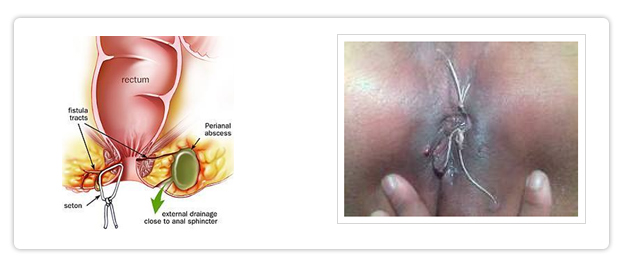Anorectal Disorders
MEDICAL AILMENTS
Fistula in Ano (Bhagandara)

What is fistula in Ano ?
- Fistula in Ano, is an abnormal connection in between the epithelial ised surface of the anal canal and (usually) the perianal skin.
- Anal fissurae originate from the anal glands, which are located between the two layers of the anal spincters and which drain into the anal canal . If the outlet of these glands becomes blocked, an abscess can form which can eventually point to the skin surface. The tract formed by this process is the fistula.
- Abscesses can recur if the fistula seals over, allowing the accumulation of pus. It then points to the surface again, and the process repeats.
What are the symptoms of a fistula ?
-
Anal fistulae can present with many different symptoms :
- Pain
- Discharge either bloody or purulent
- Pruritus ani itching
- Systemic symptoms if abscess becomes infected
What causes fistulae?
- Fistulainano is nearly always caused by a previous anorectal abscess.
- Anal canal glands situated at the dentate line afford a path for infecting organisms to reach the intramuscular spaces. The cryptoglandular hypothesis states that an infection begins in the anal gland and progresses into the muscular wall of the anal sphincters to cause an anorectal abscess.
- Following surgical or spontaneous drainage in the perianal skin, occasionally a granulation tissue–lined tract is left behind, causing recurrent symptoms.
- Multiple series have shown that the formation of a fistula tract following anorectal abscess occurs in 740% of cases.
- Other fistulas develop secondary to trauma, Crohn disease, anal fissures, carcinoma, radiation therapy, actinomycoses, tuberculosis, and chlamydial infections.
How many are the types of Fistuae?
- Submucus
- Subcutaneous
- Low anal
- High anal
- Pelvi rectal
- Recto vaginal
- Ano scrotal
- Pilonidal
How are fistulae diagnosed ?
Diagnosis is by examination, either in an outpatient setting or to as under anaesthesia (referred EUA Examination Under Anaesthesia). The examination can be an anoscopy.
- Possible findings:
- The opening of the fistula onto the skin may be seen
- The area may be painful on examination
- There may be redness
- An area of induration may be felt — thickening due to chronic infection
- A discharge may be seen
- It may be possible to explore the fistula using a fistula probe (a narrow instrument) and in this way it may be possible to find both openings of the fistula Pilonidal cysts/sinuses are another condition in which infected perianal "holes" or openings may appear
How are fistulae treated ?
-
MEDICAL MANAGEMENT :
- An anal fistula will not heal on its own. So far there is no effective medical treatment in any system of medicine worldwide.
- Although antibiotics and anti inflammatory drugs give transitional symptomatic relief at times, most persistent anal fistulae require a more aggressive approaches, such as surgery like Fistulotomy, Fistulectomy, Seton and Endorectal Advancement Flap, can require cutting the sphincters which can cause incontinence( loss of control on bowel evacuation).
SPECIAL AYURVEDIC NON SURGICAL TECHNIQUES :
- The Ksharsutra is a type of thread / medicated seton prepared by coating the thread with the Kshara (the ash obtained by the burning of various herbs) like Apamarga kshar, Arka kshar etc and Snuhi kshira.
- Apart from this, natural antibiotic like haridra powder, guggulu, etc are also used to make Ksharasutra.
- The thread is then sterilized by UV light. The mechanical action of the threads and the chemical action of the drugs coated , collectively do the work of cutting, curetting, draining, and cleaning the fistulous track, thus promoting healing of the track/ wound.
- This also acts both as the antiseptic and fibrotic agent to induce the healing.
- The process of healing starts from deeper tissues & travels towards periphery.
- This can be applied and changed periodically till the thread cuts the fistulous tract.
- Since the sphincter heals by fibrosis, there is no incontinence.
- The various studies denotes that Ksharasutra therapy is time tested treatment for fistula in ano because of its non recurrence.
- One study denoted that seton therapy is less superior and less effective than the Ayurvedic caustic ligature (Kshara sutra) 1997 Mohite JD.
- Seton therapy is effective than the modern surgical procedures like fistulectomy and fistulotomy 2002 A. Theerapol, by in Singapore medical journal.
- So the only treatments that available now for fistula in ano is fistulectomy and fistulotomy, but it is less effective than ayurvedic ksharasutra therapy.
- The Ayurvedic kshara sutra is more effective than seton, fistulotomy and fistulectomy because the following complications are never seen in any of the ksharsutra therapy given patients.
AAHARA & VIHARA (DIET & LIFE STYLE MANAGEMENT) :
- simple vegetarian diet and lifestyle changes often reduce the severity of symptoms of pain, swelling and pus discharge.
- eating a highfiber diet can make stools softer and easier to pass, reducing the pressure on fistulous tract caused by straining.
- good sources of fiber are fruits, vegetables, and whole grains. These fibers cannot be digested by the human body but helps in improving digestion and preventing constipation
- regular intake of takra(butter milk), mooli (radish), soorana (yam) are very much useful in healing of different ano rectal ailments.
- drinking six to eight glasses of water or other nonalcoholic fluids each day.
- sitting in a tub of warm water for 10 minutes several times a day.
- exercising to prevent constipation.
